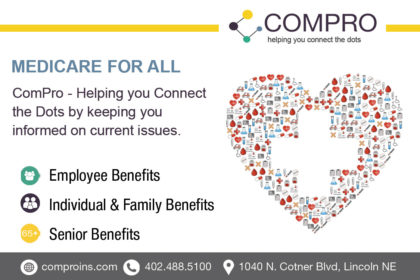ComPro – Medicare for All
As the 2020 election season moves forward, we are going to hear the phrase “Medicare for All” many times. Here is a quick look at what Medicare for All means.
The 116th Congress began in January, 2019 and continues through the 2020 elections until January, 2021. There are currently seven bills in the Senate and seven in the House of Representatives that have been introduced as Medicare for All solutions to replace or change our current systems for accessing health insurance.
These bills can be grouped into four categories:
- Single Payer: Senator Bernie Sanders and Rep Pramila Jayapal have proposed Single Payer models. Under both proposals the Single Payer plan would be provided by the federal government and offer comprehensive benefits for all US residents. It would be financed primarily through taxes. No premiums would be charged and there would be limited cost sharing for medical services that would be the responsibility of those who are participating. This would replace all private insurance offered through employers, individual coverage through carriers or healthcare.gov, Medicaid, Medicare, and other programs.
- Public Plan Option: Eight of the 14 bills that have been introduced in the Senate and the House would be considered Public Plan Options. These bills are generally targeted at offering the Public Plan Option as an alternative to healthcare.gov. The bills vary on whether employer groups could also use this as a resource. However, under all these options, an employer may continue to offer group coverage. Most of the bills also retain current sources of private and public coverage such as individual policies purchased from an insurance company, Medicare, and Medicaid.
- Medicare Buy-In: There are two bills—one in the Senate and one in the House—that give adults aged 50 and older the option to buy-in to Medicare before reaching age 65. If these individuals are eligible for subsidies through healthcare.gov, the subsidies could be applied to Medicare as well. Medicare Advantage products would also be available to those who Buy-In. All other private and public sources of health insurance would continue.
- Medicaid Buy-In: There are also two bills—one in the Senate and one in the House—that propose a Buy-In option for Medicaid. Medicare is administered at the Federal level while Medicaid is a state-based program. This concept gives each state the option to offer its residents the option to participate in Medicaid and to determine how premiums and cost sharing would apply. Once again, other private and public health insurance sources would continue.
Most of the news has been focused on Single Payer models, but most of the legislation is suggesting a hybrid solution where a Public Plan Option is available and “rescues” the Affordable Care Act. This is a highly political issue. Thirteen of the 14 bills have been introduced by Democrats.
I strongly urge you to be well versed on how this can impact your access to health insurance, your access to medical providers, your taxes, and the manner in which you operate your business!


